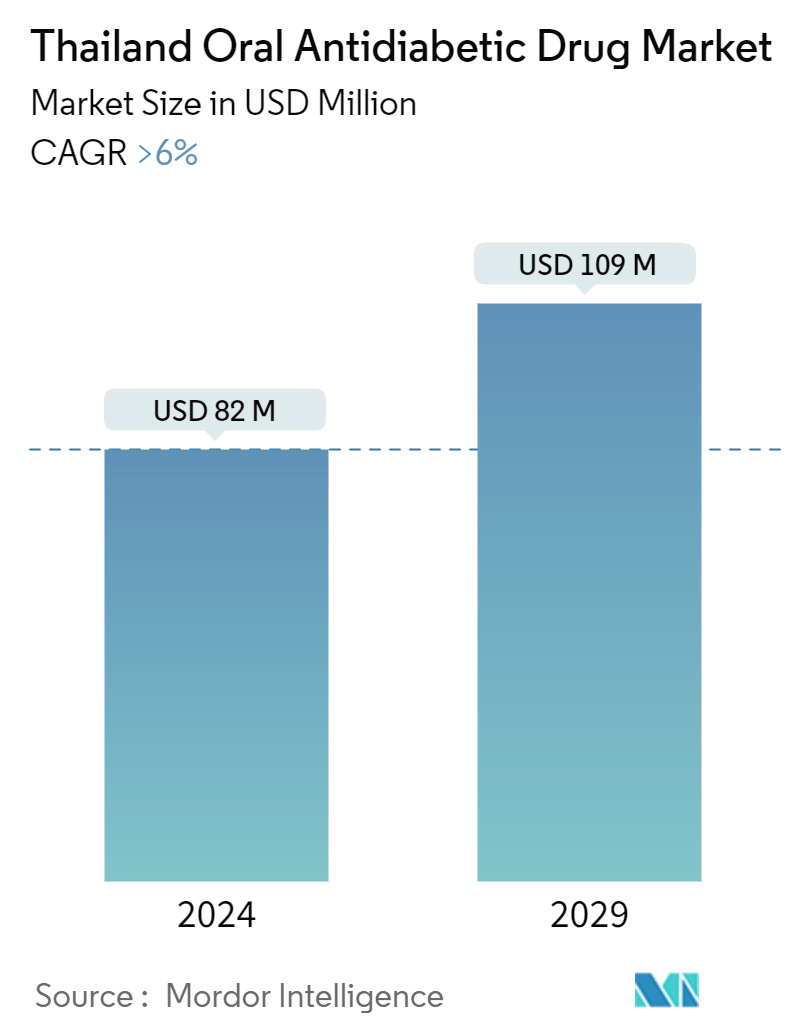Market Size of Thailand Oral Antidiabetic Drug Industry

| Study Period | 2019 - 2029 |
| Base Year For Estimation | 2023 |
| Forecast Data Period | 2024 - 2029 |
| Market Size (2024) | USD 82 Million |
| Market Size (2029) | USD 109 Million |
| CAGR (2024 - 2029) | 6.00 % |
Major Players
*Disclaimer: Major Players sorted in no particular order |
Thailand Oral Antidiabetic Drug Market Analysis
The Thailand Oral Antidiabetic Drug Market size is estimated at USD 82 million in 2024, and is expected to reach USD 109 million by 2029, growing at a CAGR of greater than 6% during the forecast period (2024-2029).
Thailand's Oral Anti-Diabetic Drug Market is expected to register a CAGR of more than 6% during the forecast period and 68 million in revenue in the current year.
Throughout each stage of the fast COVID-19 infection, the healthcare system experienced substantial disruption and strain. Some nations, most notably the Thai government, have implemented home isolation or a home quarantine program to prevent the healthcare system's collapse and address insufficient healthcare resources. The number of COVID-19 disease cases in Thailand grew to between 20,000 and 25,000 cases per day between July 2021 and October 2021, making it challenging for hospitals to manage COVID-19 infections. Previous studies demonstrated the efficacy of a COVID-19 home monitoring program utilizing telemedicine to close the treatment gap amid a global lack of healthcare workers. These programs mainly monitored the symptoms' severity and advised individuals to get more therapy if necessary. Hospital capacity was limited during COVID-19, and there was home isolation. The results in home-isolated patients with COVID-19 infection with the introduction of diabetes self-management education and support (DSMES) and glycemic treatment via telemedicine by the Thai government. The National Research Council of Thailand (NRCT) unveiled a prototype breathalyzer in AUG 2022 with a 97% accuracy rate for detecting COVID-19 infection.
A series of metabolic illnesses known as diabetes or diabetes mellitus is characterized by a person having a high blood sugar level. Diabetes is characterized by either insufficient insulin production, improper cell response to insulin, or both. The insulin medication category holds a substantial market share. Insulin is used by more than 100 million individuals globally, including 100% of those with Type 1 diabetes and 10% to 25% of those with Type 2 diabetes. Only a few insulin producers are operating on the market, and insulin production is complex. Because of this, there is tremendous competition among these companies, which always work to meet patients' needs by offering the best insulin possible.
Thailand Oral Antidiabetic Drug Industry Segmentation
Orally administered antihyperglycemic drugs reduce blood glucose levels. They are often used in type 2 diabetes care. The Thailand Oral Anti-Diabetic Drug Market is segmented into drugs (Biguanides, Alpha-glucosidase inhibitors, Dopamine-D2 receptor agonists, Sodium-glucose Cotransport-2 (SGLT-2) inhibitor, Dipeptidyl Peptidase-4 (DPP-4) Inhibitors, Sulfonylureas, and Meglitinides). The report offers the market size in value terms in USD for all the abovementioned segments.
| Oral Anti-diabetic drugs | ||||||
| ||||||
| ||||||
| ||||||
| ||||||
| ||||||
| ||||||
|
Thailand Oral Antidiabetic Drug Market Size Summary
The Thailand Oral Anti-Diabetic Drug Market is poised for significant growth over the forecast period, driven by an increasing prevalence of diabetes and the need for effective management solutions. The market is characterized by a robust primary healthcare system and universal health coverage, which facilitate access to diabetes treatments. Despite these advantages, a substantial portion of diabetes patients in Thailand struggle with managing clinical risk factors, highlighting the need for improved self-management and holistic care approaches. The market is dominated by major global players such as Eli Lilly, AstraZeneca, Sanofi, and Janssen Pharmaceuticals, who are focusing on innovative drug developments to meet the growing demand.
The market landscape is shaped by the competitive dynamics of insulin production and the strategic focus on drug segments like Sulfonylureas, which are expected to lead in revenue generation. The therapeutic landscape is further influenced by the integration of diabetes self-management education and support programs, particularly in the context of challenges posed by the COVID-19 pandemic. These programs, along with advancements in telemedicine, have played a crucial role in bridging treatment gaps. The market's growth trajectory is supported by ongoing research and development efforts, as evidenced by recent approvals and product launches aimed at enhancing blood sugar control and addressing the multifaceted nature of diabetes management in Thailand.
Thailand Oral Antidiabetic Drug Market Size - Table of Contents
-
1. MARKET DYNAMICS
-
1.1 Market Overview
-
1.2 Market Drivers
-
1.3 Market Restraints
-
1.4 Porter's Five Forces Analysis
-
1.4.1 Bargaining Power of Suppliers
-
1.4.2 Bargaining Power of Consumers
-
1.4.3 Threat of New Entrants
-
1.4.4 Threat of Substitute Products and Services
-
1.4.5 Intensity of Competitive Rivalry
-
-
-
2. MARKET SEGMENTATION
-
2.1 Oral Anti-diabetic drugs
-
2.1.1 Biguanides
-
2.1.1.1 Metformin
-
-
2.1.2 Alpha-Glucosidase Inhibitors
-
2.1.2.1 Alpha-Glucosidase Inhibitors
-
-
2.1.3 Dopamine D2 receptor agonist
-
2.1.3.1 Bromocriptin
-
-
2.1.4 SGLT-2 inhibitors
-
2.1.4.1 Invokana (Canagliflozin)
-
2.1.4.2 Jardiance (Empagliflozin)
-
2.1.4.3 Farxiga/Forxiga (Dapagliflozin)
-
2.1.4.4 Suglat (Ipragliflozin)
-
-
2.1.5 DPP-4 inhibitors
-
2.1.5.1 Onglyza (Saxagliptin)
-
2.1.5.2 Tradjenta (Linagliptin)
-
2.1.5.3 Vipidia/Nesina(Alogliptin)
-
2.1.5.4 Galvus (Vildagliptin)
-
-
2.1.6 Sulfonylureas
-
2.1.6.1 Sulfonylureas
-
-
2.1.7 Meglitinides
-
2.1.7.1 Meglitinides
-
-
-
Thailand Oral Antidiabetic Drug Market Size FAQs
How big is the Thailand Oral Antidiabetic Drug Market?
The Thailand Oral Antidiabetic Drug Market size is expected to reach USD 82 million in 2024 and grow at a CAGR of greater than 6% to reach USD 109 million by 2029.
What is the current Thailand Oral Antidiabetic Drug Market size?
In 2024, the Thailand Oral Antidiabetic Drug Market size is expected to reach USD 82 million.

